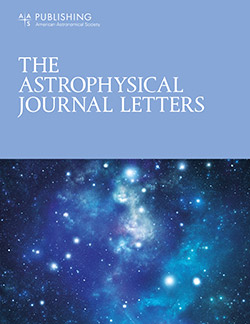On the Magnetic Nature of Quiet-Sun Chromospheric Grains
IF 8.8
1区 物理与天体物理
Q1 ASTRONOMY & ASTROPHYSICS
引用次数: 0
Abstract
Abstract Ca ii K grains, i.e., intermittent, short-lived (about 1 minute), periodic (2–4 minutes), pointlike chromospheric brightenings, are considered to be the manifestations of acoustic waves propagating upward from the solar surface and developing into shocks in the chromosphere. After the simulations of Carlsson and Stein, we know that hot shocked gas moving upward interacting with the downflowing chromospheric gas (falling down after having been displaced upward by a previous shock) nicely reproduces the spectral features of the Ca ii K profiles observed in such grains, i.e., a narrowband emission-like feature at the blue side of the line core. However, these simulations are one-dimensional and cannot explain the location or the pointlike shape of the grains. Here, we report on the magnetic nature of these events. Furthermore, we report on similar events occurring at the largest flux concentrations, though they are longer-lived (up to 8 minutes) and exhibit the typical signature of steep velocity gradients traveling across the atmosphere. The spectral signatures of the studied events resemble their counterparts in sunspots, the umbral flashes. We then propose that magnetohydrodynamical waves are not only channeled through the magnetic field in sunspots, but they pervade the whole atmosphere. The propagation along magnetic fields can explain the pointlike appearance of the calcium grains observed in the quiet chromosphere.关于安静太阳色球颗粒的磁性
Ca ii K颗粒,即间歇性的、短暂的(约1分钟)、周期性的(2-4分钟)、点状的色球亮,被认为是声波从太阳表面向上传播并在色球层发展成激波的表现。在Carlsson和Stein的模拟之后,我们知道向上移动的热激波气体与向下流动的色球气体相互作用(在被先前的激波向上取代后下降)很好地再现了在这些颗粒中观察到的Ca ii K剖面的光谱特征,即线核蓝色一侧的窄带发射样特征。然而,这些模拟是一维的,不能解释颗粒的位置或点状形状。在这里,我们报道这些事件的磁性。此外,我们报告了在最大通量浓度下发生的类似事件,尽管它们持续时间较长(长达8分钟),并表现出穿越大气的陡峭速度梯度的典型特征。所研究事件的光谱特征与太阳黑子的对应物——本影闪光相似。然后我们提出磁流体动力波不仅在太阳黑子的磁场中传播,而且遍及整个大气。沿着磁场的传播可以解释在安静色球中观察到的钙颗粒的点状外观。
本文章由计算机程序翻译,如有差异,请以英文原文为准。
求助全文
约1分钟内获得全文
求助全文
来源期刊

Astrophysical Journal Letters
ASTRONOMY & ASTROPHYSICS-
CiteScore
14.10
自引率
6.30%
发文量
513
审稿时长
2-3 weeks
期刊介绍:
The Astrophysical Journal Letters (ApJL) is widely regarded as the foremost journal for swiftly disseminating groundbreaking astronomical research. It focuses on concise reports that highlight pivotal advancements in the field of astrophysics. By prioritizing timeliness and the generation of immediate interest among researchers, ApJL showcases articles featuring novel discoveries and critical findings that have a profound effect on the scientific community. Moreover, ApJL ensures that published articles are comprehensive in their scope, presenting context that can be readily comprehensible to scientists who may not possess expertise in the specific disciplines covered.
 求助内容:
求助内容: 应助结果提醒方式:
应助结果提醒方式:


